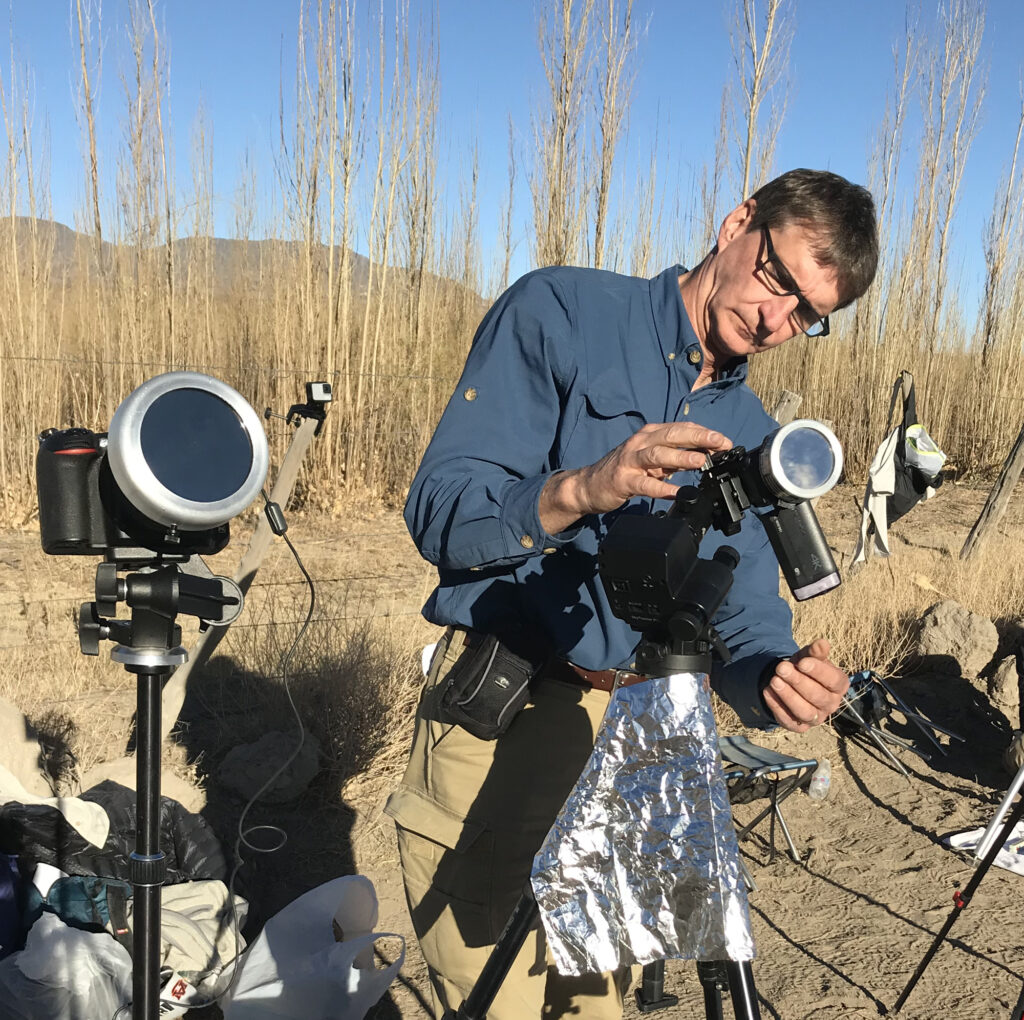On April 8, millions of Americans will don protective glasses to gaze up at the Great North American Eclipse, the first total solar eclipse to cast its otherworldly shadow on the U.S. since 2017. Among those watching will be Alabama’s own Gordon Telepun, an astronomer and eclipse expert who is on a mission to help others experience this amazing celestial event.
A Decatur-area plastic surgeon by vocation, Telepun is also an eclipse chaser (“umbraphile”) by avocation, a pursuit that has taken him to Africa, Argentina, the Mediterranean Sea and Tennessee to photograph and study total solar eclipses. According to Telepun, next month’s total solar eclipse, his sixth in 23 years, is a golden eclipse-viewing opportunity for several reasons: it’s a long eclipse (over four minutes in many locations compared to 2017, which was 2 minutes, 40 seconds at maximum duration); its “path of totality”—the narrow band of deepest shadow where all the best eclipse phenomena occur—will cut across 13 U.S. states from Texas to Maine providing a great view to millions of people; and it will be the last total eclipse in the U.S. until 2045. In short, if you’ve ever dreamed of seeing an eclipse or are just curious about what weird things can happen when the Moon obscures the Sun, this is the one to see. And, as his story illustrates, it could be the first of many. — Katie Jackson

You began chasing eclipses in 2001, but when did you see your very first eclipse?
When I was a kid, 6 years old, I remember being on summer vacation at the New Jersey shore. My dad knew there was going to be an eclipse (likely the 1963 total solar eclipse in Canada) and we would be able to see the partial eclipse in New Jersey on our vacation, so he brought welding glasses to the beach. I remember the experience, although not the actual view through the welding glass.
What keeps drawing you back to see them again and again?
I love the challenge of doing the photography manually and improving my techniques and results. I love figuring out the combinations of gear to use. Each corona is different; you just don’t know what you will see. Every eclipse has a unique but subtle ambient “feeling” to it. Each eclipse has a different crowd to enjoy it with. You meet fun and interesting people who are also eclipse chasers.
A total eclipse is full of surprises, including a rare look at the Sun’s corona. What other phenomena can occur?
I have a special interest in the phenomena that are created as the Moon passes in front of the Sun, some of which can only be witnessed at an eclipse. The temperature drops, there are interesting light effects to be enjoyed like pinhole projection of the crescents, witnessing sharp and fuzzy shadows, the eerie gray hue that overtakes the observing area due to the way our retinas perform in low light. Animals are fooled by the approaching darkness and start their nighttime behaviors, and shadow bands caused by the final slit of light penetrating the atmosphere also occur.
What can an eclipse reveal about the Universe?
It allows you to see the motion of the heavenly bodies in real time. Most people don’t appreciate the motion of the orbit of the Earth and the Moon because most people don’t stand outside and watch the moon move for an hour (or longer) to see it shift relative to a fixed point. But during an eclipse you are watching the orbit of the Moon and the rotation of the Earth all at once.
How much of the eclipse will we see in Alabama and how can we maximize the experience here at home?
Alabama is not in the path of totality so a total eclipse and corona will not be seen here. But a relatively deep partial eclipse (from 92 percent in northwestern Alabama, which is closer to the eclipse’s path, and decreasing as you move southeast) will be seen and some phenomena can still be enjoyed. You should be able to feel the temperature drop. You can see and photograph crescent-shaped shadows formed when the eclipsed Sun shines through leaves or project them through the holes in kitchen utensils, hats or anything else with small holes. You even punch holes in thin cardboard and project your name as crescents.
What tools have you developed to make it easier and more fun to watch an eclipse?
I developed the Solar Eclipse Timer, a “talking” phone app that guides users (and photographers) through important partial phase phenomena, things like contact times, when to put on and take off protective glasses and reminders to look for interesting eclipse phenomena). I also wrote an e-book, Eclipse Day 2024 and More! How To Enjoy, Observe, and Photograph a Total Solar Eclipse, that is organized by the progression of the eclipse and includes everything you need to know about enjoying, observing and photographing an eclipse. And the app and the book work together.
To learn more about the 2024 eclipse, Telepun’s book and app and see his extensive collection of eclipse videos visit solareclipsetimer.com or youtube.com/@solareclipsetimer. To learn more about the 2024 eclipse, including how to safely view it, visit science.nasa.gov/eclipses/future-eclipses/eclipse-2024 and go to shadowandsubstance.com to see local totality percentages.





